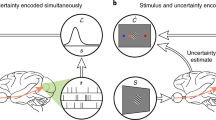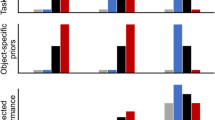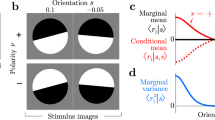Abstract
The ability to search efficiently for a target in a cluttered environment is one of the most remarkable functions of the nervous system. This task is difficult under natural circumstances, as the reliability of sensory information can vary greatly across space and time and is typically a priori unknown to the observer. In contrast, visual-search experiments commonly use stimuli of equal and known reliability. In a target detection task, we randomly assigned high or low reliability to each item on a trial-by-trial basis. An optimal observer would weight the observations by their trial-to-trial reliability and combine them using a specific nonlinear integration rule. We found that humans were near-optimal, regardless of whether distractors were homogeneous or heterogeneous and whether reliability was manipulated through contrast or shape. We present a neural-network implementation of near-optimal visual search based on probabilistic population coding. The network matched human performance.
This is a preview of subscription content, access via your institution
Access options
Subscribe to this journal
Receive 12 print issues and online access
$209.00 per year
only $17.42 per issue
Buy this article
- Purchase on Springer Link
- Instant access to full article PDF
Prices may be subject to local taxes which are calculated during checkout








Similar content being viewed by others
References
Palmer, J., Ames, C.T. & Lindsey, D.T. Measuring the effect of attention on simple visual search. J. Exp. Psychol. Hum. Percept. Perform. 19, 108–130 (1993).
Treisman, A.M. & Gelade, G. A feature-integration theory of attention. Cognit. Psychol. 12, 97–136 (1980).
Estes, W.D. & Taylor, R.M. A detection method and probabilistic models for assessing information processing from brief visual displays. Proc. Natl. Acad. Sci. USA 52, 446–454 (1964).
Shaw, M.L. Identifying attentional and decision-making components in information processing. in Attention and Performance (ed. R.S. Nickerson) 277–296 (Erlbaum, Hillsdale, New Jersey, 1980).
Teichner, W.H. & Krebs, M.J. Visual search for simple targets. Psychol. Bull. 81, 15–28 (1974).
Palmer, J., Verghese, P. & Pavel, M. The psychophysics of visual search. Vision Res. 40, 1227–1268 (2000).
Duncan, J. & Humphreys, G.W. Visual search and stimulus similarity. Psychol. Rev. 96, 433–458 (1989).
Rosenholtz, R. Visual search for orientation among heterogeneous distractors: experimental results and implications for signal detection theory models of search. J. Exp. Psychol. Hum. Percept. Perform. 27, 985–999 (2001).
Eriksen, C.W. Object location in a complex perceptual field. J. Exp. Psychol. 45, 126–132 (1953).
Farmer, E.W. & Taylor, R.M. Visual search through color displays: effects of target-background similarity and background uniformity. Percept. Psychophys. 27, 267–272 (1980).
Knill, D.C. & Richards, W. Perception as Bayesian Inference (Cambridge University Press, New York, 1996).
Knill, D.C. & Pouget, A. The Bayesian brain: the role of uncertainty in neural coding and computation. Trends Neurosci. 27, 712–719 (2004).
Ma, W.J., Beck, J.M., Latham, P.E. & Pouget, A. Bayesian inference with probabilistic population codes. Nat. Neurosci. 9, 1432–1438 (2006).
Morgan, M.L., DeAngelis, G.C. & Angelaki, D.E. Multisensory integration in macaque visual cortex depends on cue reliability. Neuron 59, 662–673 (2008).
Verghese, P. Visual search and attention: a signal detection theory approach. Neuron 31, 523–535 (2001).
Eckstein, M.P., Peterson, M.F., Pham, B.T. & Droll, J.A. Statistical decision theory to relate neurons to behavior in the study of covert visual attention. Vision Res. 49, 1097–1128 (2009).
Najemnik, J. & Geisler, W.S. Optimal eye movement strategies in visual search. Nature 434, 387–391 (2005).
Eckstein, M.P., Thomas, J.P., Palmer, J. & Shimozaki, S.S. A signal detection model predicts the effects of set size on visual search accuracy for feature, conjunction, triple conjunction, and disjunction displays. Percept. Psychophys. 62, 425–451 (2000).
Green, D.M. & Swets, J.A. Signal Detection Theory and Psychophysics (John Wiley & Sons, Los Altos, California, 1966).
Peterson, W.W., Birdsall, T.G. & Fox, W.C. The theory of signal detectability. IRE Prof. Group Inf. Theory 4, 171–212 (1954).
Nolte, L.W. & Jaarsma, D. More on the detection of one of M orthogonal signals. J. Acoust. Soc. Am. 41, 497–505 (1967).
Eckstein, M.P. The lower visual search efficiency for conjunctions is due to noise and not serial attentional processing. Psychol. Sci. 9, 111–118 (1998).
Graham, N., Kramer, P. & Yager, D. Signal dection models for multidimensional stimuli: probability distributions and combination rules. J. Math. Psychol. 31, 366–409 (1987).
Quick, R.F. A vector-magnitude model of contrast detection. Kybernetik 16, 65–67 (1974).
Pouget, A., Dayan, P. & Zemel, R.S. Inference and Computation with Population Codes. Annu. Rev. Neurosci. 26, 381–410 (2003).
Bremmer, F., Ilg, U., Thiele, A., Distler, C. & Hoffman, K. Eye position effects in monkey cortex. I. Visual and pursuit-related activity in extrastriate areas MT and MST. J. Neurophysiol. 77, 944–961 (1997).
Andersen, R.A., Essick, G. & Siegel, R. Encoding of spatial location by posterior parietal neurons. Science 230, 456–458 (1985).
Heeger, D.J. Normalization of cell responses in cat striate cortex. Vis. Neurosci. 9, 181–197 (1992).
Reynolds, J.H. & Heeger, D.J. The normalization model of attention. Neuron 61, 168–185 (2009).
Beck, J., Latham, P. & Pouget, A. Complex Bayesian inference in neural circuits using divisive normalization. Front. Syst. Neurosci. Conference Abstract: Computational and Systems Neuroscience 2009, doi: 10.3389/conf.neuro.06.2009.03.109 (2 February 2009).
Seung, H.S. & Sompolinsky, H. Simple model for reading neuronal population codes. Proc. Natl. Acad. Sci. USA 90, 10749–10753 (1993).
Schoups, A., Vogels, R., Qian, N. & Orban, G. Practising orientation identification improves orientation coding in V1 neurons. Nature 412, 549–553 (2001).
Regan, D. & Beverley, K.I. Spatial–frequency discrimination and detection: comparison of postadaptation thresholds. J. Opt. Soc. Am. 73, 1684–1690 (1983).
Kiani, R. & Shadlen, M.N. Representation of confidence associated with a decision by neurons in the parietal cortex. Science 324, 759–764 (2009).
Kim, B. & Basso, M.A. Saccade target selection in the superior colliculus: a signal detection theory approach. J. Neurosci. 28, 2991–3007 (2008).
Kepecs, A., Uchida, N., Zariwala, H.A. & Mainen, Z.F. Neural correlates, computation and behavioural impact of decision confidence. Nature 455, 227–231 (2008).
Deneve, S., Latham, P. & Pouget, A. Reading population codes: a neural implementation of ideal observers. Nat. Neurosci. 2, 740–745 (1999).
Ogawa, T. & Komatsu, H. Target selection in area V4 during a multidimensional visual search task. J. Neurosci. 24, 6371–6382 (2004).
Bichot, N.P., Rossi, A.F. & Desimone, R. Parallel and serial neural mechanisms for visual search in macaque area V4. Science 308, 529–534 (2005).
Gottlieb, J.P., Kusunoki, M. & Goldberg, M. The representation of visual salience in monkey parietal cortex. Nature 391, 481–484 (1998).
Knill, D.C. Mixture models and the probabilistic structure of depth cues. Vision Res. 43, 831–854 (2003).
Kersten, D., Mamassian, P. & Yuille, A. Object perception as Bayesian inference. Annu. Rev. Psychol. 55, 271–304 (2004).
Itti, L. & Koch, C. Computational modeling of visual attention. Nat. Rev. Neurosci. 2, 194–203 (2001).
Navalpakkam, V. & Itti, L. Search goal tunes visual features optimally. Neuron 53, 605–617 (2007).
Zhang, L., Tong, M.H., Marks, T.K., Shan, H. & Cottrell, G.W. SUN: a Bayesian framework for saliency using natural statistics. J. Vis. 8, 1–20 (2008).
Vincent, B.T., Baddeley, R.J., Troscianko, T. & Gilchrist, I.D. Optimal feature integration in visual search. J. Vis. 9, 1–11 (2009).
Beck, J.M. et al. Bayesian decision-making with probabilistic population codes. Neuron 60, 1142–1152 (2008).
Brainard, D.H. The Psychophysics Toolbox. Spat. Vis. 10, 433–436 (1997).
MacKay, D.J. Information Theory, Inference and Learning Algorithms (Cambridge University Press, Cambridge, UK, 2003).
Cover, T.M. & Thomas, J.A. Elements of Information Theory (John Wiley & Sons, New York, 1991).
Acknowledgements
W.J.M. is supported by award R01EY020958 from the National Eye Institute. V.N. is supported by National Science Foundation grant #0820582. J.M.B. is supported by the Gatsby Charitable Foundation and R.v.d.B. by the Netherlands Organization for Scientific Research (NWO). A.P. is supported by Multidisciplinary University Research Initiative grant N00014-07-1-0937, National Institute on Drug Abuse grant #BCS0346785, a research grant from the James S. McDonnell Foundation and award P30EY001319 from the National Eye Institute.
Author information
Authors and Affiliations
Contributions
W.J.M., V.N. and R.v.d.B. designed the experiments. V.N. and R.v.d.B. collected the data. W.J.M., V.N. and R.v.d.B. analyzed the data. W.J.M., J.B. and A.P. developed the theory. J.B. performed the network simulations. W.J.M. and A.P. wrote the manuscript. V.N., J.B. and R.v.d.B. contributed to the writing of the manuscript.
Corresponding author
Ethics declarations
Competing interests
The authors declare no competing financial interests.
Supplementary information
Supplementary Text and Figures
Supplementary Figures 1–16, Supplementary Tables 1 and 2, and Supplementary Results (PDF 3590 kb)
Rights and permissions
About this article
Cite this article
Ma, W., Navalpakkam, V., Beck, J. et al. Behavior and neural basis of near-optimal visual search. Nat Neurosci 14, 783–790 (2011). https://doi.org/10.1038/nn.2814
Received:
Accepted:
Published:
Issue Date:
DOI: https://doi.org/10.1038/nn.2814
This article is cited by
-
Bayesian prediction of psychophysical detection responses from spike activity in the rat sensorimotor cortex
Journal of Computational Neuroscience (2023)
-
Revealing nonlinear neural decoding by analyzing choices
Nature Communications (2021)
-
A neural basis of probabilistic computation in visual cortex
Nature Neuroscience (2020)
-
Efficient probabilistic inference in generic neural networks trained with non-probabilistic feedback
Nature Communications (2017)
-
Neural representation of probabilities for Bayesian inference
Journal of Computational Neuroscience (2015)



